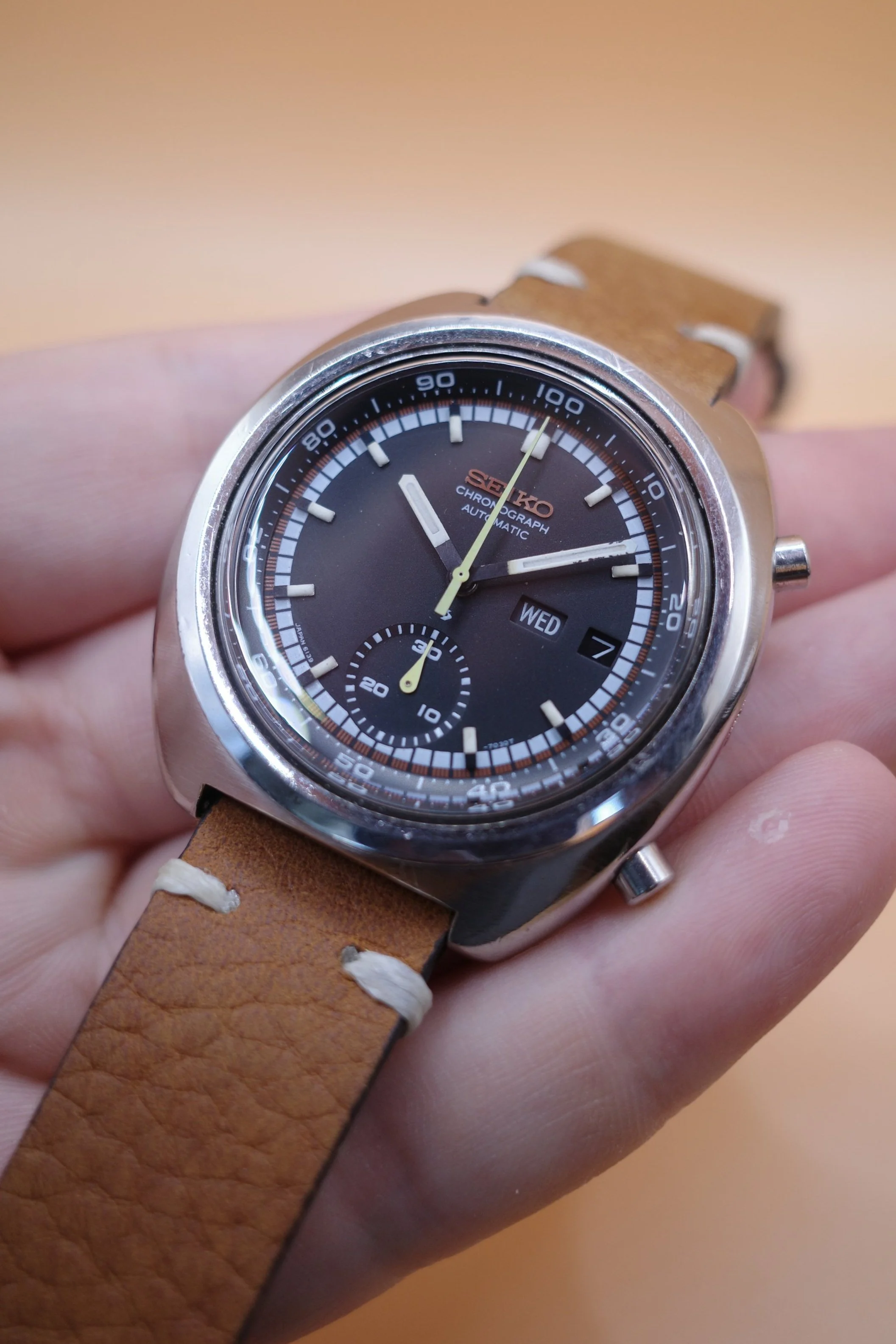Seiko 6139 Automatic Chronograph
NOW SOLD
There are a few arguments with regard to who created the first automatic chronograph movement. Zenith wears the crown and gets all of the glory but Seiko deserves proper credit, launching the worlds first in 1969.
"It’s well known that Swiss companies were working feverishly in the 1960s to develop a self-winding chronograph, but no one knows whether their Japanese competitors knew about these efforts. Seiko started working on the self-winding Calibers 6139 and 6138 in 1967, even though by then much of the watch industry was focusing its attention on quartz technology. It took the company just two years to develop Caliber 6139. Remarkably small, it had a diameter of 27.4 mm and a height of 6.5 mm. Its mainspring was a ball-borne, center-mounted rotor, which worked in conjunction with Seiko’s innovative Magic Lever (still in use today), a click-winding system that can use the rotor’s kinetic energy regardless of which way the rotor turns. After being fully wound, the watch would run for 36 hours with the chronograph switched on." Gisbert Brunner, WatchTime.com
Own a piece of this history with an amazing ref. 6139 with yellow subdial registers and chronograph seconds hand, Roman numeral and English day wheel. Japan JDM model. Keeps great time. Some light minute hand degradation. Matte dial is nearly flawless. Hands, Crown, Pusher and Dial components all original to the watch.
All functions of this example operate perfectly.
Brand: Seiko
Model: Automatic Chronograph
Reference: 6139
Year: Circa 1970s
Material: Stainless steel
Dimensions: 41 mm diameter; 14mm thick case
Crystal: Plexiglass
Lume: Yes, however non luminous due to age
Caliber: Seiko, self-winding 6139
Bracelet/Strap: Brown leather
Lug Width: 18mm
NOW SOLD
There are a few arguments with regard to who created the first automatic chronograph movement. Zenith wears the crown and gets all of the glory but Seiko deserves proper credit, launching the worlds first in 1969.
"It’s well known that Swiss companies were working feverishly in the 1960s to develop a self-winding chronograph, but no one knows whether their Japanese competitors knew about these efforts. Seiko started working on the self-winding Calibers 6139 and 6138 in 1967, even though by then much of the watch industry was focusing its attention on quartz technology. It took the company just two years to develop Caliber 6139. Remarkably small, it had a diameter of 27.4 mm and a height of 6.5 mm. Its mainspring was a ball-borne, center-mounted rotor, which worked in conjunction with Seiko’s innovative Magic Lever (still in use today), a click-winding system that can use the rotor’s kinetic energy regardless of which way the rotor turns. After being fully wound, the watch would run for 36 hours with the chronograph switched on." Gisbert Brunner, WatchTime.com
Own a piece of this history with an amazing ref. 6139 with yellow subdial registers and chronograph seconds hand, Roman numeral and English day wheel. Japan JDM model. Keeps great time. Some light minute hand degradation. Matte dial is nearly flawless. Hands, Crown, Pusher and Dial components all original to the watch.
All functions of this example operate perfectly.
Brand: Seiko
Model: Automatic Chronograph
Reference: 6139
Year: Circa 1970s
Material: Stainless steel
Dimensions: 41 mm diameter; 14mm thick case
Crystal: Plexiglass
Lume: Yes, however non luminous due to age
Caliber: Seiko, self-winding 6139
Bracelet/Strap: Brown leather
Lug Width: 18mm
NOW SOLD
There are a few arguments with regard to who created the first automatic chronograph movement. Zenith wears the crown and gets all of the glory but Seiko deserves proper credit, launching the worlds first in 1969.
"It’s well known that Swiss companies were working feverishly in the 1960s to develop a self-winding chronograph, but no one knows whether their Japanese competitors knew about these efforts. Seiko started working on the self-winding Calibers 6139 and 6138 in 1967, even though by then much of the watch industry was focusing its attention on quartz technology. It took the company just two years to develop Caliber 6139. Remarkably small, it had a diameter of 27.4 mm and a height of 6.5 mm. Its mainspring was a ball-borne, center-mounted rotor, which worked in conjunction with Seiko’s innovative Magic Lever (still in use today), a click-winding system that can use the rotor’s kinetic energy regardless of which way the rotor turns. After being fully wound, the watch would run for 36 hours with the chronograph switched on." Gisbert Brunner, WatchTime.com
Own a piece of this history with an amazing ref. 6139 with yellow subdial registers and chronograph seconds hand, Roman numeral and English day wheel. Japan JDM model. Keeps great time. Some light minute hand degradation. Matte dial is nearly flawless. Hands, Crown, Pusher and Dial components all original to the watch.
All functions of this example operate perfectly.
Brand: Seiko
Model: Automatic Chronograph
Reference: 6139
Year: Circa 1970s
Material: Stainless steel
Dimensions: 41 mm diameter; 14mm thick case
Crystal: Plexiglass
Lume: Yes, however non luminous due to age
Caliber: Seiko, self-winding 6139
Bracelet/Strap: Brown leather
Lug Width: 18mm










